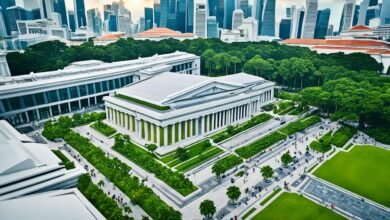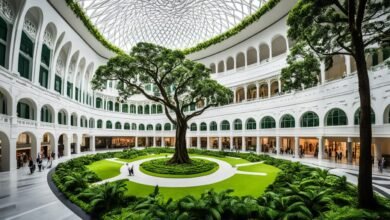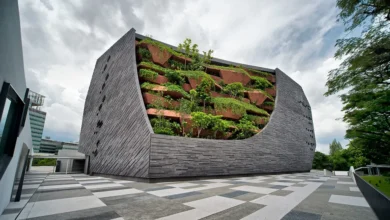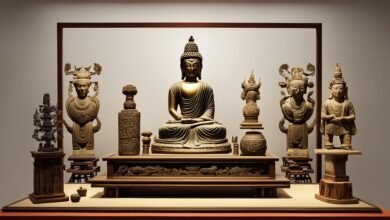Table of Contents
Step into a vibrant world where traditions and history intertwine. Imagine diving into the Peranakan culture. Here, every artifact and display tells a story of Chinese, Malay, and Indian fusion.
As you explore the Peranakan Museum, you feel the culture’s warmth and beauty. History and art dance together, and traditions meet modern expressions. It’s where past, present, and future meet, touching your soul deeply.
The name Peranakan Museum awakens a deep curiosity. Every step inside invites you on a journey of discovery.
Imagine seeing exquisite Peranakan artifacts, each a precious heirloom. Trace the Peranakan people’s history, *their trials, triumphs, and enduring spirit*. Admire their traditional dress and intricate beadwork, showing incredible craftsmanship.
Exploring colorful Peranakan cuisine stories is enchanting. The air fills with spices’ aroma, tempting your taste. Every flavorful curry and delicate nonya dessert shares the community’s love for food.
The Peranakan Museum is more than artifacts and stories. It’s a gateway to shared experiences and vivid cultural celebrations. Whether of Peranakan descent or simply drawn to cultural diversity, this museum will deeply move you.
Let the Peranakan Museum awaken your senses and spirit. It transports you to a world where cultures blend and traditions thrive.
The History and Origins of the Peranakan People
The Peranakan people boast a rich heritage that began in the 15th century. They came from Chinese traders marrying local Malay and Indonesian women. This mix created a vibrant community with diverse cultural roots. They’re known as the Straits Chinese or the King’s Chinese. These names highlight their past and status as British subjects during colonial times.
Looking into the Peranakan community’s history informs us about the mix of Chinese, Malay, and Western cultures. At the Peranakan Museum, you’ll find the fascinating story of this community. The museum displays artifacts, stories, and exhibits that show Peranakan life vividly.
The museum explains how the Peranakan people’s stories weave together. It shows their journey across oceans and adapting to new places. It’s a chance to learn about their complex cultural mix and lifestyle.
The Peranakan community, with its diverse origins and rich history, represents a unique cultural heritage that has left an indelible mark on Southeast Asia.
Diving into the history of the Peranakan people helps you cherish their customs, traditions, and regional contributions. The Peranakan Museum is full of knowledge. It encourages you to discover the complex Peranakan community for a rich cultural experience.
Exploring Peranakan Artifacts at the Peranakan Museum
The Peranakan Museum is full of artifacts from the Peranakan people. It gives visitors a detailed look into their interesting culture. You will see jewelry, furniture, textiles, and traditional clothing. This museum tells the full story of Peranakan heritage.
One key attraction is the traditional Nonya kebaya dresses on display. The detail in the beadwork and embroidery on these dresses is stunning. It shows the skilled craftsmanship unique to the Peranakan style.
“The Nonya kebaya is a testament to the fusion of Chinese, Malay, and Indian influences that define Peranakan culture. Its intricate designs and vibrant colors reflect the unique identity of Peranakan women,” says curator Mei Ling.
The museum also celebrates Peranakan food, known as nonya food. It combines Chinese cooking with Malay and Indonesian tastes. The museum shows how this unique mix creates delicious dishes. From spicy curries to sweet desserts, nonya food is fascinating.
Visiting the Peranakan Museum lets you dive into their culture and history. You’ll learn about wedding customs and everyday life. By looking at each artifact, you understand more about the Peranakan heritage. It’s an enriching experience.
| Peranakan Artifacts | Peranakan Traditional Dress | Peranakan Cuisine |
|---|---|---|
| Jewelry | Nonya Kebaya | Nonya Food |
| Furniture | Beadwork | Chinese-Malay Flavors |
| Textiles | Embroidery | Indonesian Influences |
Rediscovering Peranakan Lifestyle and Beliefs
Visiting the Peranakan Museum is fascinating. It lets you explore the unique lifestyle and beliefs of the Peranakan people. Their vibrant traditions, ceremonies, and beliefs are on display.
Religion is vital in Peranakan culture. It mixes Chinese, Malay, and Indonesian influences. The museum shows off their various spiritual practices.
Public life is key for Peranakans too. The museum covers their role in society, business, and charity. Their impact is significant where they live.
Peranakan Wedding Customs
Peranakan weddings are captivating. The Peranakan Museum offers a glimpse into these rich ceremonies and traditions.
“Weddings are big in Peranakan culture. They symbolize the joining of two families. The museum displays beautiful bridal attire and wedding rituals. These ceremonies showcase the Peranakan heritage.” – Peranakan Museum Curator
Exploring Peranakan wedding customs is enlightening. The museum explains the importance of each tradition. This includes engagement to wedding banquets.
Unique Traditions and Ceremonies
The Museum also highlights other Peranakan traditions. These range from ancestral worship to yearly festivities. It’s a chance to explore Peranakan heritage further.
Celebrations like Chinese New Year and the Hungry Ghost Festival are detailed. Understanding these helps grasp the Peranakan way of life.
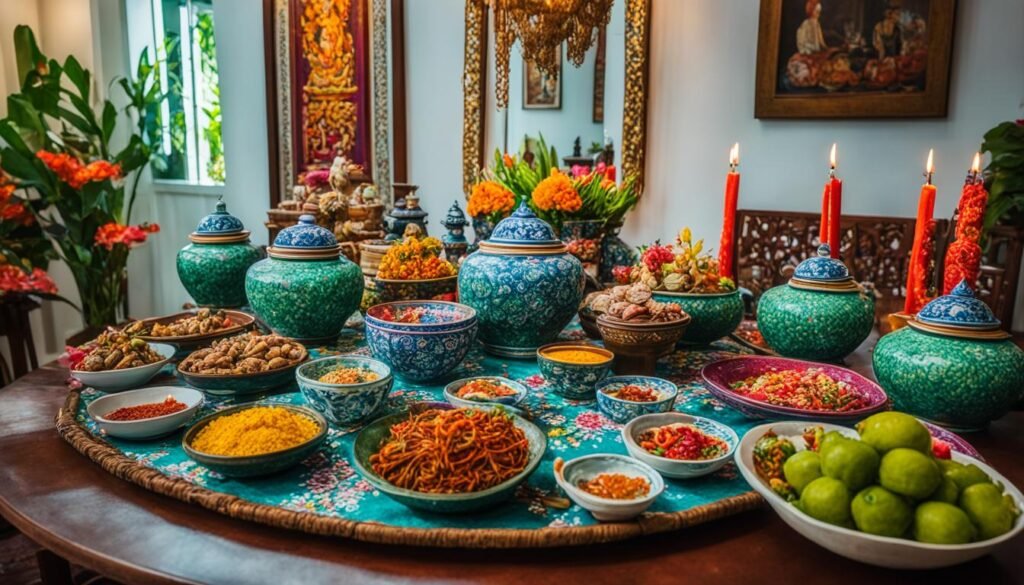
The Peranakan Museum is a deep dive into their vibrant culture. By exploring, you learn about the traditions and beliefs that define Peranakans. It’s a journey that enriches your understanding of their unique lifestyle.
The Symbolism of Peranakan Porcelain
At the Peranakan Museum, a special gallery spotlights Straits Chinese porcelain. This collection highlights unique designs and soft enamels typical of Peranakan art. These beautiful pieces show the wealth of the Peranakan people and their important cultural role. Peranakan porcelain is more than just art. It also reflects the community’s eating traditions and might even inspire people to enjoy food more.
The museum’s collection of Straits Chinese porcelain includes many beautiful pieces. They have delicate flower designs, bright patterns, and detailed work. The soft enamel colors make each piece look graceful and elegant. These pieces show the amazing skills of Peranakan artists.
| Peranakan Porcelain Characteristics | Symbolism and Significance |
|---|---|
| Pastel Enamels | The use of soft, pastel hues symbolizes the refined taste and elegance of the Peranakan community. It reflects their affinity for beauty and harmony. |
| Floral Motifs | Flowers hold deep symbolic meaning in Peranakan culture. Each variety represents various virtues and aspirations, such as prosperity, longevity, and purity. |
| Peony | The peony, in particular, is a popular motif in Peranakan porcelain. It symbolizes wealth, honor, and high social status. |
| Phoenix and Dragon | These mythical creatures represent harmony and auspiciousness. Their presence on Peranakan porcelain evokes wishes for good fortune and prosperity. |
Peranakan porcelain also shows the cultural mix of the Peranakan people. The ceramics blend Chinese, Malay, and Indonesian influences. This mix shows how the Peranakan people adapted to different cultures while keeping their identity.
The Peranakan Museum offers a look into the meaning of Straits Chinese porcelain. It helps visitors understand the history, traditions, and values of the Peranakan culture. Exploring Peranakan porcelain, you’ll develop a deep respect for their rich heritage and culture.
Peranakan Women in Art and Culture
Peranakan women greatly impact the community’s art and culture. The Peranakan Museum celebrates their talents. They were experts in embroidery and beadwork, known for their beautiful designs and colors. They shared their creativity and culture through their craft.
The museum shows the detailed embroidery and beadwork of these women. It gives a peek into their capabilities and Peranakan culture’s beautiful art. Their works show their commitment and love for their craft.
Their art mixes different cultural influences unique to the Peranakan community. Vibrant colors and complex patterns in their embroidery tell stories and keep their heritage alive. Embroidery is crucial in Peranakan art, from traditional dresses to household items.
Beadwork is another craft Peranakan women excelled in. Their beadwork on jewelry and accessories brought elegance to their outfits. Their skill in combining beads created gorgeous designs, showing the lively Peranakan spirit.
Peranakan beadwork
“The art of Peranakan women in embroidery and beadwork shows their creativity. It also shows their effort to keep their culture alive.”
The Peranakan Museum honors Peranakan women’s art, giving them a stage for their stories and skills. Their art has helped shape the community’s culture, adding to Peranakan heritage’s richness.
Exploring the Peranakan Wedding Bed
The Peranakan Museum showcases the Peranakan Wedding Bed, a key artifact. It stands for family, tradition, and cultural heritage. By exploring Peranakan wedding customs, visitors learn about the role of marriage and family. The wedding bed highlights the values of the Peranakan community.
Peranakan wedding customs are deeply traditional, crucial to their culture. The bed, with its elaborate designs, is very meaningful. It’s not just for sleep; it signifies the coming together of two families and the start of their new life.
Peranakan family traditions are key to their wedding ceremony. It’s a grand event, full of symbolism and rituals. These steps convey the importance of family and respect in Peranakan culture.
“The Peranakan Wedding Bed is not only a beautiful piece of furniture but a representation of our cherished customs and traditions. It serves as a reminder of the importance we place on family and the preservation of our culture.”
Peranakan wedding beds feature beautiful carvings. Skilled artisans craft these symbols, showing the community’s artistic side. They highlight the art and craftsmanship in Peranakan culture.
At the Peranakan Museum, dive into the cultural importance of marriage and family. By exploring traditions and customs, you appreciate the Peranakan people’s heritage.
The Symbolism of the Peranakan Wedding Bed
The Peranakan Wedding Bed is more than furniture; it encapsulates Peranakan values and traditions. Here’s a deeper look at its symbolism:
| Symbol | Meaning |
|---|---|
| Ornate Carvings | Reflect Peranakan artistic heritage and add aesthetic beauty to the bed |
| Embroidered Canopy | Symbolizes blessings and protection for the newlyweds |
| Red Color Accents | Signify luck, joy, and prosperity in Peranakan culture |
| Auspicious Symbols | Represent blessings for fertility, harmony, and good fortune |
| Family Crests | Highlight the lineage and ancestral ties of the marrying families |
The Peranakan Wedding Bed shows Peranakan family traditions and cultural values. It symbolizes the significance of marriage, family, and enduring customs.
A Taste of Peranakan Cuisine
Peranakan cuisine, also known as nonya food, is captivating. It is rich and spicy, blending Chinese, Malay, and Indonesian tastes. Ingredients like rempah and coconut milk are key. Try the babi pongteh, a tasty braised pork dish. Or, sample ayam buah keluak, featuring chicken in a rich black nut sauce.
The Peranakan Museum showcases this cuisine’s beauty beyond taste. It dives into how these traditional dishes are made. Learn about the skill in grinding spices and the art in adding colorful garnishes. This tradition shows incredible artistry.
Peranakan cuisine mixes unique flavors, rich history, and community pride. It invites us on a journey to discover and cherish vibrant Peranakan tastes that have lasted through time.
If you love exploring new foods, Peranakan cuisine is a must-try. Its bold, aromatic dishes are unforgettable. Dive into this culture’s flavorful world and get ready for a memorable culinary adventure.
Uncovering the Flavors of Peranakan Cuisine:
Here are some iconic Peranakan dishes:
- Ayam Buah Keluak – Chicken simmered in black nut sauce.
- Babi Pongteh – Braised pork in a rich soybean paste with mushrooms and potatoes.
- Itek Sio – Braised duck in a tangy tamarind sauce.
- Lobak – Deep-fried meat rolls wrapped in bean curd skin.
- Chap Chye – Mixed vegetable stew cooked with prawns and pork belly.
| Dish | Description |
|---|---|
| Ayam Buah Keluak | Chicken simmered in a rich black nut sauce, served with the unique Indonesian black nuts. |
| Babi Pongteh | Braised pork dish cooked in a savory soybean paste, mushrooms, and potatoes. |
| Itek Sio | Braised duck in a tangy tamarind sauce, garnished with fresh herbs. |
| Lobak | Deep-fried meat rolls wrapped in bean curd skin, served with a tangy chili dipping sauce. |
| Chap Chye | Mixed vegetable stew cooked with prawns and tender slices of pork belly. |
Peranakan Art and Craftsmanship
Visit the Peranakan Museum to see the amazing art and craftsmanship of the Peranakan community. They are experts in beadwork, embroidery, and porcelain design. Their creations reflect their unique culture.
Enter the colorful world of Peranakan art. It’s where intricate beadwork meets vivid colors. The result is eye-catching pieces. The detailed beadwork tells stories through art. Each bead and stitch is placed with care. This shows the artists’ skill and love for their work.
Learn about Peranakan embroidery too. It’s where threads bring stories to life in bright colors and patterns. This embroidery shares tales and traditions of the community. Its fine work makes each piece special.
“Peranakan art and craft are key to keeping cultural heritage alive. They blend history and creativity beautifully.” – [Peranakan artist name]
Peranakan porcelain is another example of their art. Its smooth shapes, detailed designs, and soft colors show Peranakan elegance. These porcelain items are more than just pretty. They are part of the culture, showing the love for good food and fine living.
At the Peranakan Museum, dive into Peranakan art and craft. See the beauty, stories, and legacy in every piece. Discover the magic of their beadwork, embroidery, and porcelain. You’ll learn to appreciate the Peranakan community’s creativity even more.
Peranakan Heritage beyond the Peranakan Museum
The Peranakan Museum is a key spot for learning about Peranakan culture. But, there are two private museums in the area that show more sides of this culture. They reveal more about the Peranakan people’s history, traditions, and their role in society. These places help keep the heritage alive and let us explore Peranakan culture more deeply.
At these museums, you can closely look into Peranakan customs and ways of life. You’ll find various artifacts, art, and interactive displays. These highlight the important cultural marks left by the Peranakan community.
Visiting these museums offers a closer look at Peranakan history and its impact. Dip into this culture’s past and present in these engaging cultural spots.
The Heritage Preservation: Honoring the Past, Connecting the Present
It’s vital to keep Peranakan heritage alive. Private Peranakan museums are key to this. They gather artifacts, host shows, and have educational programs. These help maintain the culture.
These museums work with the Peranakan community to share real stories and traditions. They preserve Peranakan heritage for future generations. They’re places where the community’s cultural feats are celebrated, fostering pride in Peranakan identity.
Seeing these museums helps preserve and promote Peranakan culture. Your visit aids in keeping this rich heritage vibrant for future generations.
Peranakan Community: A Living Tradition
The Peranakan community actively shapes Southeast Asian society. Private museums celebrate Peranakan people’s roles and offer a stage for their stories, traditions, and skills.
These exhibits and interactive elements spotlight Peranakan talent and achievements. They show everything from fashion and food to modern Peranakan art. It’s a testament to the Peranakan spirit of resilience and innovation.
A Glimpse into Peranakan Heritage
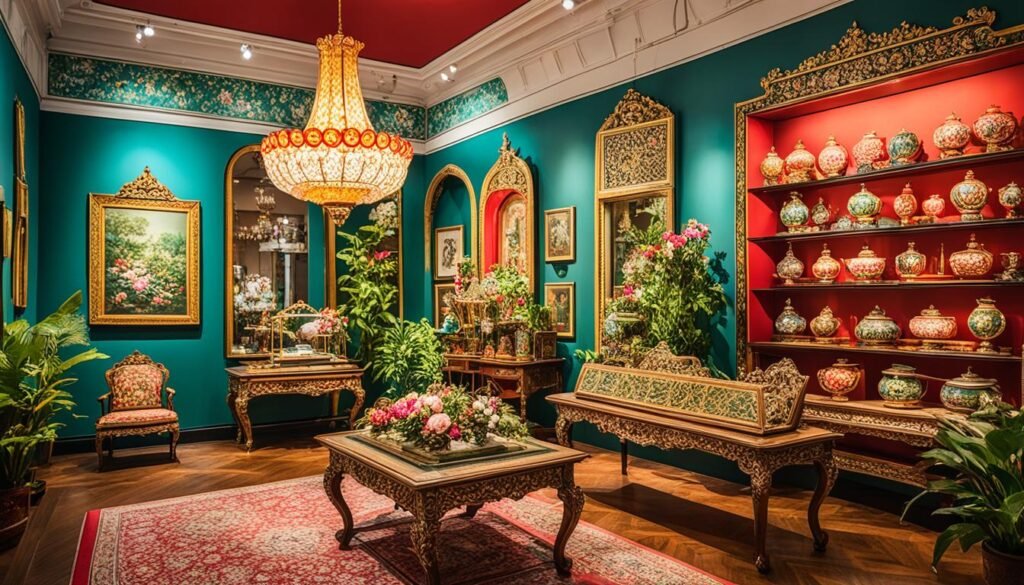
Explore the diverse Peranakan heritage in these private museums:
| Museum | Location | Highlights |
|---|---|---|
| Baba-Nonya Heritage Museum | Malacca | Explore the beautifully restored Baba-Nonya house and discover its traditional architecture, exquisite antiques, and intricate artwork. |
| Pinang Peranakan Mansion | Penang | Step into the opulent world of the Peranakan elite as you wander through the grand mansion filled with stunning furniture, heirlooms, and artifacts. |
Plan a visit to these museums to uncover Peranakan community’s secrets and stories. Dive into the heritage and legacy of this rich, enduring culture.
Conclusion: Immersing Yourself in Peranakan Culture at the Peranakan Museum
Take an unforgettable trip into culture at Singapore’s famous Peranakan Museum. This museum lets you dive deep into the colorful Peranakan culture. It shows history, traditions, and arts of the Peranakan people with artifacts, interactive shows, and displays.
Start an adventure of learning about the Peranakan community’s background. You’ll see how Chinese, Malay, and Indian cultures mix. There are many Peranakan artifacts and traditional clothes to see, offering glimpses into this unique heritage.
While exploring the museum, marvel at the Peranakan art and skill. Admire their fine beadwork, embroidery, and beautiful Peranakan porcelain. Their artworks show their love for beauty and detail.
Don’t delay your visit! Head to the Peranakan Museum for a deep dive into culture. Experience the Peranakan Museum and see the Peranakan culture alive in Singapore.
